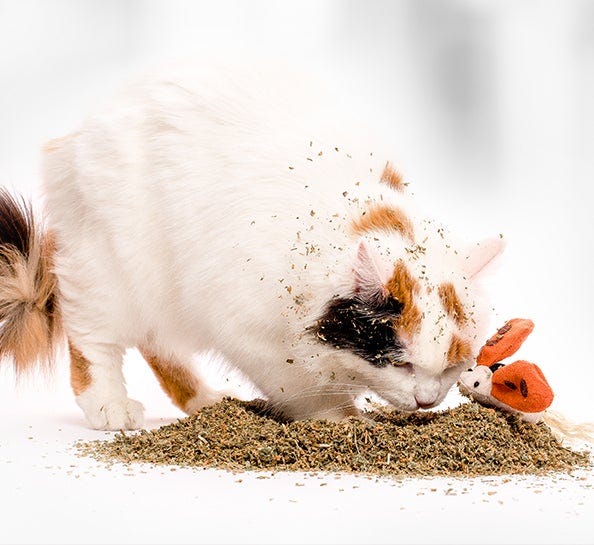
If you’re a cat owner or just a cat lover, you’ve probably heard of catnip. It’s a plant that is famous for its effects on felines – many cats go crazy over it! But have you ever wondered if cats actually eat catnip? In this article, we’ll explore this question and delve into what catnip is, how it affects cats, and whether or not it’s safe for them to consume.
What is Catnip?
Catnip is a herb that belongs to the mint family. It’s also known by its scientific name, Nepeta cataria. The plant is native to Europe, Asia, and Africa but has also been introduced to other parts of the world. Catnip contains a chemical compound called nepetalactone, which is what makes it so attractive to cats.
How Does Catnip Affect Cats?
When cats smell or ingest catnip, the nepetalactone interacts with receptors in their brains, triggering a response. This response varies from cat to cat, but it often includes behaviors such as rolling around, rubbing their faces in the catnip, and playing with it. Some cats may become more active, while others may become more relaxed and sedated.
It’s important to note that not all cats are affected by catnip. The sensitivity to nepetalactone is actually genetic and not all cats carry the gene that makes them react to it.
Do Cats Eat Catnip?
So, do cats eat catnip? The answer is yes, some cats do eat catnip. However, it’s not a common behavior and not all cats are interested in eating it. If a cat does decide to eat catnip, they may chew on the leaves or ingest small amounts of the plant.
Eating catnip doesn’t have the same effect as smelling or playing with it. In fact, cats that eat catnip may not show any visible reaction at all. The nepetalactone in catnip needs to be inhaled for it to have an effect on a cat’s behavior.
Is Catnip Safe for Cats to Eat?
Catnip is considered to be non-toxic to cats, so eating small amounts of it shouldn’t be harmful. However, eating large amounts of catnip can cause vomiting and diarrhea in cats. If your cat does eat a large amount of catnip and starts to show signs of illness, it’s best to contact your veterinarian.
It’s also worth noting that catnip is not a substitute for a cat’s regular diet. While it’s not harmful in small amounts, it doesn’t provide any nutritional value and shouldn’t be a significant part of a cat’s diet.
Can Cats Become Addicted to Catnip?
Cats can’t become physically addicted to catnip, but they can become dependent on it for entertainment. Some cats may become obsessed with catnip and demand it regularly. However, this behavior is more about the cat’s love for play and stimulation than an addiction to the chemical compound in catnip.
How to Give Your Cat Catnip
If you want to give your cat catnip, there are a few different ways to do it. You can buy dried catnip at a pet store or online and sprinkle it on your cat’s toys, scratching posts, or bedding. Some cats also enjoy fresh catnip, which you can grow in a pot at home.
It’s important to note that not all cats will be interested in catnip, and some may not react to it at all. If you’re introducing catnip to your cat for the first time, start with a small amount and see how they react. Also, remember that the effects of catnip are temporary, lasting anywhere from a few minutes to a few hours, depending on the cat. >Alternatives to Catnip
If your cat doesn’t react to catnip or if you want to provide them with other forms of stimulation, there are plenty of alternatives to try. Some cats enjoy silver vine, valerian root, or honeysuckle wood. These plants contain compounds that have similar effects to nepetalactone and can provide your cat with entertainment and stimulation.
Toys and activities that mimic hunting and prey can also be enjoyable for cats. Interactive toys, such as wand toys or puzzle feeders, can help keep your cat mentally and physically stimulated. Regular playtime and exercise are important for cats and can help prevent behavioral problems.
Conclusion
In conclusion, cats can eat catnip, but it’s not a common behavior and doesn’t have the same effect as smelling or playing with it. Eating small amounts of catnip is considered safe for cats, but large amounts can cause vomiting and diarrhea. While catnip can be a fun form of entertainment for some cats, it’s not a substitute for a balanced diet and regular exercise.
If you’re considering giving your cat catnip, start with a small amount and monitor their reaction. Remember that not all cats react to catnip, and there are plenty of alternatives to try if your cat isn’t interested. As always, consult with your veterinarian if you have any concerns about your cat’s health or behavior.
So, the next time you’re wondering if cats eat catnip, the answer is yes, but it’s not the most common behavior. However, the effects of catnip on cats are undeniable, and it’s a fun and safe way to provide your cat with entertainment and stimulation.

Bình luận về bài viết này